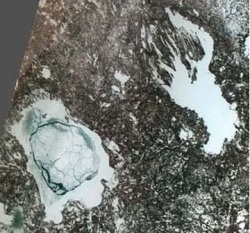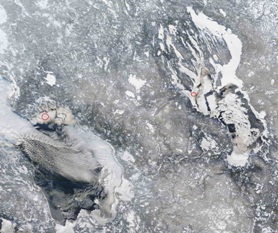 |  |
| 21st March 2012 | 21st March 2015 |
MAIN IDEA OF THE PROJECT
The proposed project focuses on the study of the wintertime dynamics of the system of Great European lakes (case study of Lake Ladoga). The system of Great European Lakes (Ladoga and Onego) is an important resource for drinking water, transport (Baltic Sea to White Sea and Caspian Sea), energy, use of biological resources and recreation. It is primarily conceived as a synthesis of multifaceted interdisciplinary studies to be conducted by a team of experts from Russia and Switzerland, as well as France, Germany, and Sweden. These studies are essential because of the present lack of knowledge of processes under ice and the functioning of the lake’s ecosystem during the 5-7 month period (November - May) from freeze-up to ice break-up.
The results will have direct practical implications with respect to lake management for estimating possible pathways of water pollution and for determining the optimal location of drinking water intakes for St. Petersburg, Sortavala and other cities and towns on the shores of Lake Ladoga.
RESEARCH AIMS AND PROGRAM
The research program aims at investigating life under ice and relevant physical, chemical and biological processes. In particular, we would like to understand under-ice convections and their implications for ecosystem development. For this, four sub-projects will simultaneously measure physical and biological parameters under-ice. Instruments will be set on a mooring during the entire winter period. During the ice-covered period, traditional methods will be applied from ice holes. In addition, automatic underwater vehicles will allow to horizontally map the convection structures, and remote sensing from drones will identify spatial heterogeneity of the ice cover. The functioning of the ecosystem will be further investigated by analyzing phytoplankton, zooplankton and bacteria, as well as carbon dioxide transfer throughout the trophic system. The reconstruction of land use history in the catchment area will be explained using sediment cores.
UNDER ICE FIELD CAMPAIGN OF MEASUREMENTS
LOGISTICS FOR FIELDWORK
Fieldwork is scheduled to take place before, after and during the ice-covered period. The aim of the ice-free period fieldwork is to determine the conditions after and before the ice-covered period, and to set up moored instruments that will record conditions under ice throughout the winter. A longer fieldwork will take place on ice in March during two consecutive years. We propose the following partitioning:
1. On ice – March 2015: 15 days;
2. After ice break-up – May 2015: 3 days (+ 4 days travel from Petrozavodsk to Lake Ladoga by boat);
3. Before freezing – October 2015: 3 days (+ 4 days travel from Petrozavodsk to Lake Ladoga by boat);
4. On ice – March 2016: 15 days;
5. After ice break-up – May 2016: 3 days (+ 4 days travel from Petrozavodsk to Lake Ladoga by boat).
During the free-ice period, the research vessel Ecolog from NWPI will perform a lake-wide survey.
From the ice in March, campaigns will be organized similarly to North Polar studies by AARI. For this, tents will be installed above drilled ice holes. The research team will be transported to the site by snowmobile, hydroplane or helicopter, depending on ice conditions.
TIME SCHEDULE OF UNDER-ICE FIELD CAMPAIGN OF MEASUREMENTS:
Lake Onego from 13th to 27th March, 2015, Lake Ladoga in March 2016.
DATA ANALYSIS AND MODELLING
This subproject will result in qualitative and quantitative description of the vertical structure of water temperature and velocity fields at the observation sites, and will provide insight into the nature of physical processes that govern the evolution of these fields. One of the main scopes will be to evaluate the ability of updraught convection velocities to restrain phytoplankton cells within the Convective Boundary Layer. In a second integration step, data from nutrients and light profiles will be integrated in a hydrodynamic model to describe the development of phytoplankton under ice, which will be compared to the turbidity, absorption and chlorophyll profiles in order to quantify biomass development. The field measurements will provide the necessary data to develop a simple model that will examine the contribution of nutrient availability, light and physical forcing to phytoplankton development.
RESULTS
Improved understanding of the functioning of the lake ecosystems under ice will be achieved.
The effect of ice and snow parameters on phytoplankton development under ice will be quantified.
Main features and the composition of phytoplankton and cryophytes in Lake Ladoga under ice will be identified.
Variations of the ecosystem under ice will be reproduced by numerical models.
Practical recommendations (optimal distribution of water intakes, water management) will be worked out.
OUTPUTS OF THE PROJECT
Scientific reports.
Book and articles in international journals.
Publications in newspapers.
Recommendations to decision-makers on water protection and related practical actions, such as the siting for water intake facilities.
Scientific reports.
Book and articles in international journals.
Publications in newspapers.
Recommendations to decision-makers on water protection and related practical actions, such as the siting for water intake facilities.
SCIENTIFIC INSTITUTIONS
| Northern Water Problems Institute (NWPI), Karelian Research Center RAS, Petrozavodsk, Institute of Limnology (IL), RAS, St. Petersburg, Arctic and Antarctic Research Institute (AARI), St. Petersburg, Nansen International Environments and Remote Sensing Center (NIERSC), St. Petersburg | Ecole Polytechnique Fédérale de Lausanne (EPFL), Lausanne University of Geneva (UNIGE), Forel Institute, Geneva Eawag, Dübendorf University of Konstanz, Konstanz, Germany, Uppsala University, Uppsala, Sweden, UMR CARRTEL, Limniques/Alpine Research Centre on Lake Food webs, INRA-Thonon-les-Bains, France |
Address in Russia | Address in Switzerland |
| Аl. Nevsky Pr. 50 186003 Petrozavodsk Republic of Karelia, Russia Phone: +78142576381 е-mail: nwpi.karelia@yandex.ru http:// www.nwpi.krc.ru | Avenue de Rumine 13, CH-1005 Lausanne, Switzerland Phone: +41 (0)21 693 59 43 |



